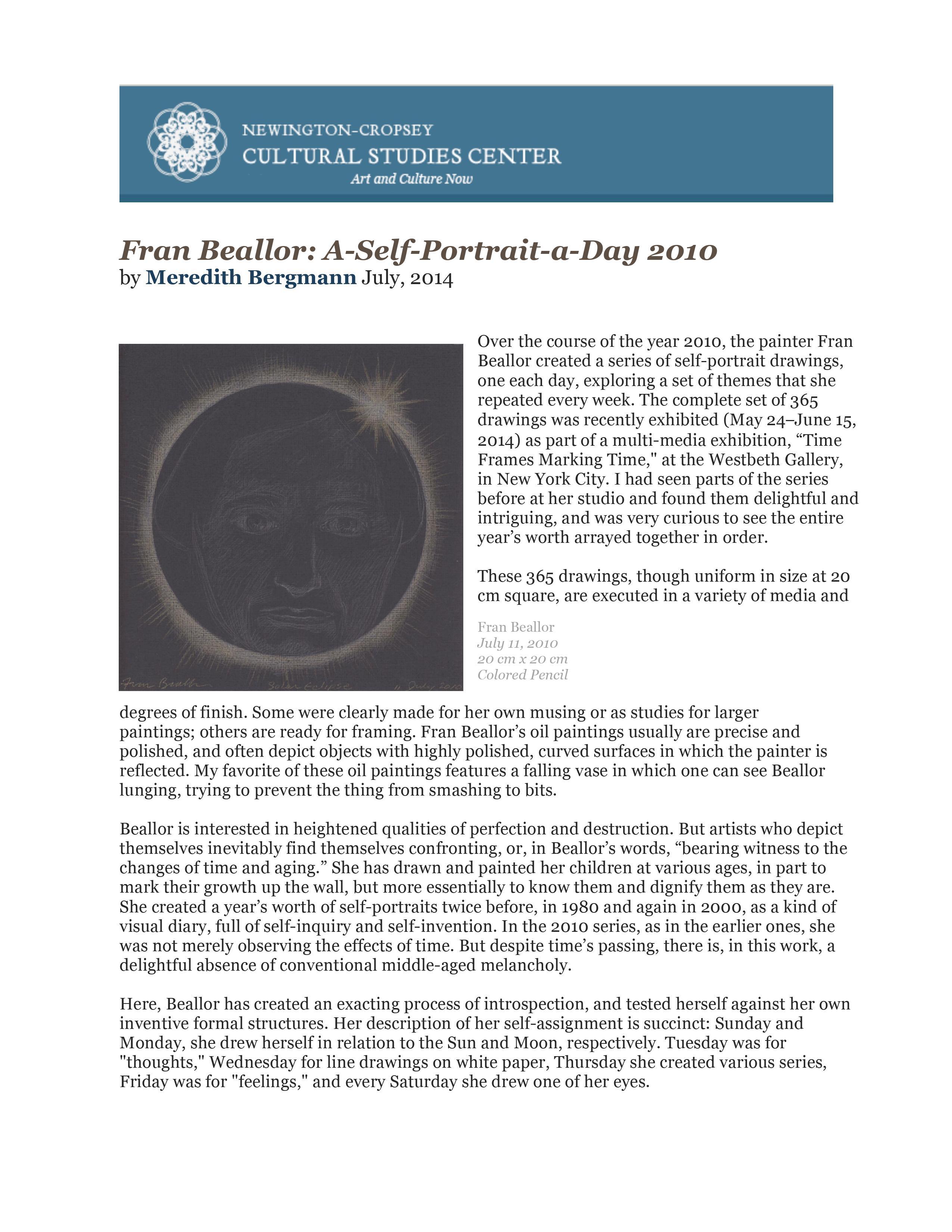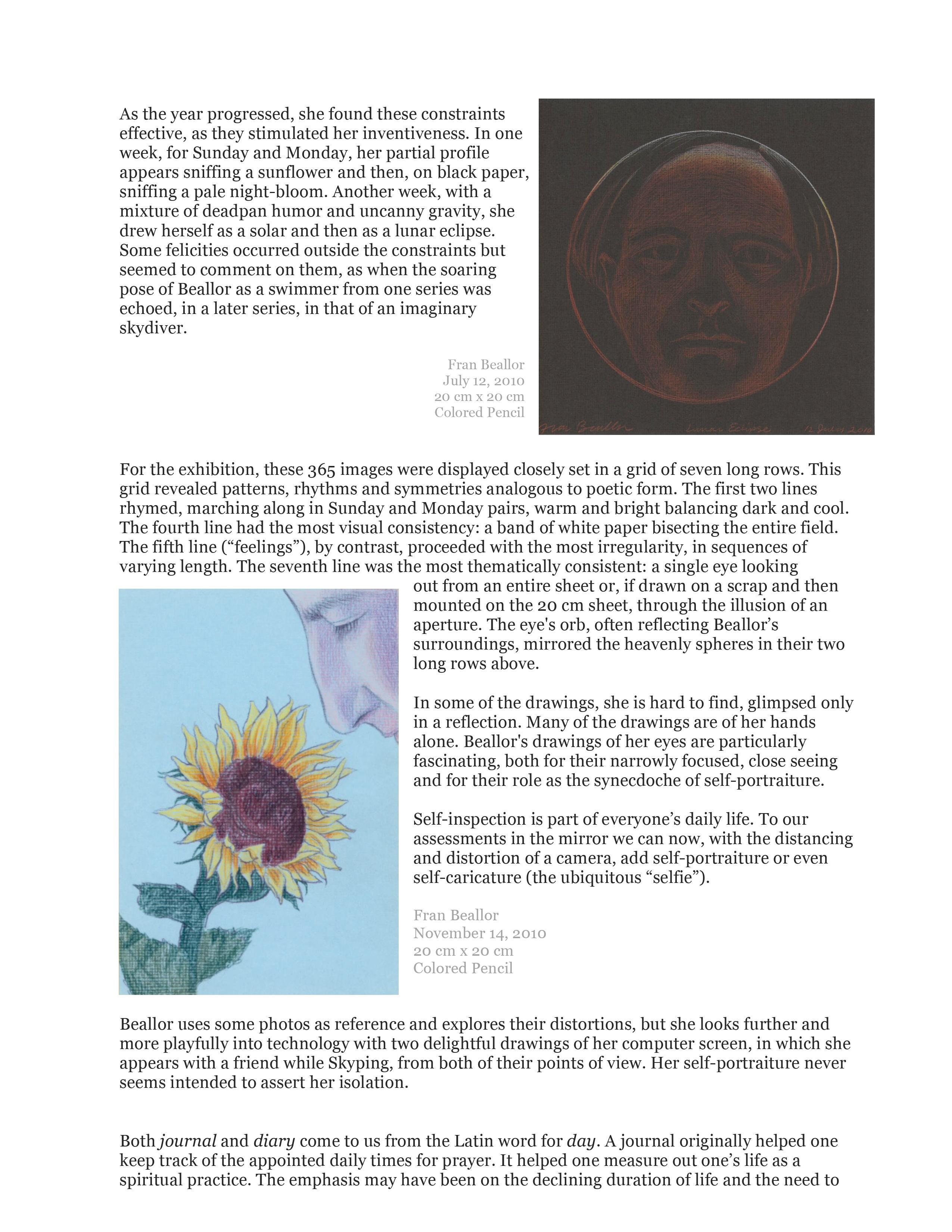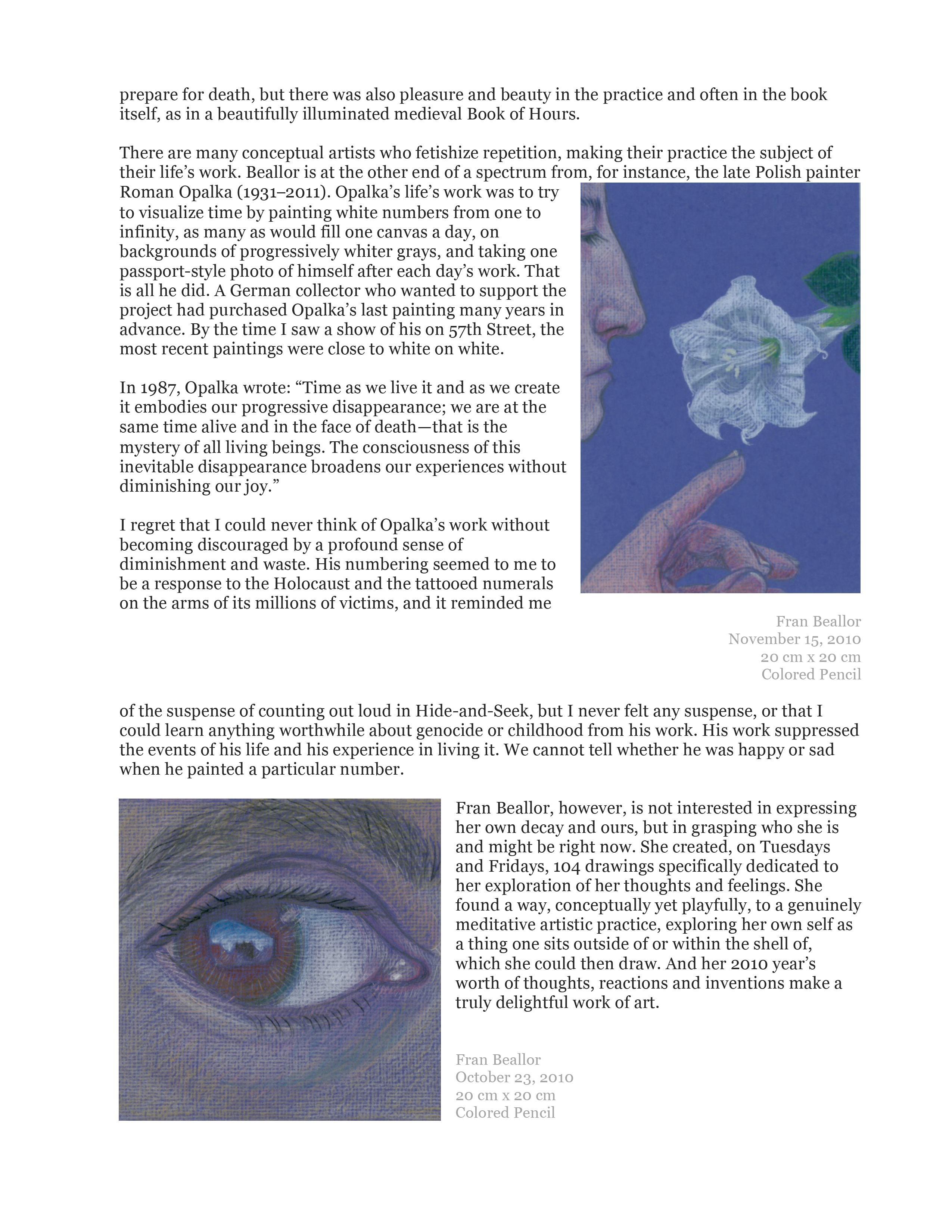Fran Beallor: A-Self-Portrait-A-Day 2010 (article text)
by Meredith Bergmann April, 2014
Over the course of the year 2010, the painter Fran Beallor created a series of self-portrait drawings, one each day, exploring a set of themes that she repeated every week. The complete set of 365 drawings was recently exhibited as part of a multi-media exhibition, “Time Frames Marking Time”, at the Westbeth Gallery. I’d seen parts of the series before at her studio and found them delightful and intriguing, and was very curious to see the entire year’s worth arrayed together in order.
These 365 drawings, though uniform in size at 20 cm square, are executed in a variety of media and degrees of finish. Some were clearly made for her own musing or as studies for larger paintings; others are ready for framing. Fran Beallor’s oil paintings usually are precise and polished, and often depict objects with highly polished, curved surfaces in which the painter is reflected. My favorite of these oil paintings features a falling vase in which one can see Beallor lunging, trying to prevent the thing from smashing to bits.
Beallor is interested in heightened qualities of perfection and destruction. But artists who depict themselves inevitably find themselves confronting, or, in Beallor’s words, “bearing witness to the changes of time and aging.” She has drawn and painted her children at various ages, in part to mark their growth up the wall, but more essentially to know them and dignify them as they are. She created a year’s worth of self-portraits twice before, in 1980 and again in 2000, as a kind of visual diary, full of self-inquiry and self-invention. In the 2010 series, as in the earlier ones, she was not merely observing the effects of time. But despite time’s passing there is, in this work, a delightful absence of conventional middle-aged melancholy.
Here, Beallor has created an exacting process of introspection, and tested herself against her own inventive formal structures. Her description of her self-assignment is succinct: Sunday and Monday she drew herself in relation to the Sun and Moon, respectively. Tuesday was for "thoughts", Wednesday for line drawings on white paper, Thursday she created various series, Friday was for "feelings", and every Saturday she drew one of her eyes.
As the year progressed she found these constraints effective, as they stimulated her inventiveness. In one week, for Sunday and Monday, her partial profile appears sniffing a sunflower and then, on black paper, sniffing a pale night-bloom. Another week, with a mixture of deadpan humor and uncanny gravity, she drew herself as a solar and then as a lunar eclipse. Some felicities occurred outside the constraints but seem to comment on them, as when the soaring pose of Beallor as a swimmer from one series is echoed, in a later series, in that of an imaginary skydiver.
For the exhibition, these 365 images were displayed closely set in a grid of seven long rows. This grid revealed patterns, rhythms and symmetries analogous to poetic form. The first two lines rhymed, marching along in Sunday and Monday pairs, warm and bright balancing dark and cool. The fourth line had the most visual consistency: a band of white paper bisecting the entire field. The fifth line (“feelings”), by contrast, proceeded with the most irregularity in sequences of varying length. The seventh line was the most thematically consistent: a single eye looking out from an entire sheet or, if drawn on a scrap and then mounted on the 20cm sheet, through the illusion of an aperture. The eye's orb, often reflecting Beallor’s surroundings, mirrored the heavenly spheres in their two long rows above.
In some of the drawings she is hard to find, glimpsed only in a reflection. Many of the drawings are of her hands alone. Beallor's drawings of her eyes are particularly fascinating, both for their narrowly focused, close seeing and for their role as the synecdoche of self-portraiture.
Self-inspection is part of everyone’s daily life. To our assessments in the mirror we can now, with the distancing and distortion of a camera, add self-portraiture or even self-caricature (the ubiquitous “selfie”). Beallor uses some photos as reference and explores their distortions, but she looks further and more playfully into technology with two delightful drawings of her computer screen, in which she appears with a friend while Skyping, from both of their points of view. Her self-portraiture never seems intended to assert her isolation.
Both “journal” and “diary” come to us from the Latin word for “day”. A journal originally helped one keep track of the appointed daily times for prayer. It helped one measure out one’s life as a spiritual practice. The emphasis may have been on the declining duration of life and the need to prepare for death, but there was also pleasure and beauty in the practice and often in the book itself, as in a beautifully illuminated medieval Book of Hours.
There are many conceptual artists who fetishize repetition, making their practice the subject of their life’s work. Beallor is at the other end of a spectrum from, for instance, the late Polish painter Roman Opalka (1931-2011). Opalka’s life’s work was to try to visualize time by painting white numbers from one to infinity, as many as would fill one canvas a day, on backgrounds of progressively whiter grays, and taking one passport-style photo of himself after each day’s work. That’s all he did. A German collector who wanted to support the project had purchased Opalka’s last painting many years in advance. By the time I saw a show of his on 57th Street, the most recent paintings were close to white on white.
In 1987 Opalka wrote, “Time as we live it and as we create it embodies our progressive disappearance; we are at the same time alive and in the face of death–that is the mystery of all living beings. The consciousness of this inevitable disappearance broadens our experiences without diminishing our joy.”
I regret that I could never think of Opalka’s work without becoming discouraged by a profound sense of diminishment and waste. His numbering seemed to me to be a response to the Holocaust and the tattooed numerals on the arms of its millions of victims, and it reminded me of the suspense of counting out loud in Hide-and-Seek, but I never felt any suspense, or that I could learn anything worthwhile about genocide or childhood from his work. His work suppressed the events of his life and his experience in living it. We cannot tell whether he was happy or sad when he painted a particular number.
Fran Beallor, however, is not interested in expressing her own decay and ours, but in grasping who she is and might be right now. She created, on Tuesdays and Fridays, 104 drawings specifically dedicated to her exploration of her thoughts and feelings. She found a way, conceptually yet playfully, to a genuinely meditative artistic practice, exploring her own self as a thing one sits outside of or within the shell of, which she could then draw. And her 2010 year’s worth of thoughts, reactions and inventions make a truly delightful work of art.


